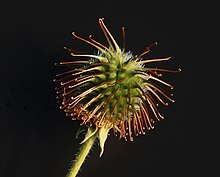



A bur (also spelled burr)[1] is a seed or dry fruit or infructescence that has hooks or teeth. The main function of the bur is to spread the seeds of the bur plant, often through epizoochory. The hooks of the bur are used to latch onto fur or fabric, enabling the bur – which contain seeds – to be transported to another location for dispersal.[2] Another use for the spines and hooks are physical protection against herbivores.[3] Their ability to stick to animals and fabrics has shaped their reputation as bothersome.
Some other forms of diaspores, such as the stems of certain species of cactus also are covered with thorns and may function as burs.
Bur-bearing plants, such as Tribulus terrestris and Xanthium species, are often single-stemmed when growing in dense groups, but branch and spread when growing singly.[2] The number of burs per fruit along with the size and shape can vary largely between different bur plants.[4]
- ^ Cook, J. Gordon (1968). ABC of Plant Terms. Watford, Herts: Merrow. OCLC 223208923.
- ^ a b "Noogoora burr, Californian burr, Italian cockleburr and South American burr (Xanthium species)". New South Wales Department of Primary Industries. 2009.
- ^ Cite error: The named reference
:2was invoked but never defined (see the help page). - ^ Gorb, Elena; Gorb, Stanislav (2002-04-01). "Contact separation force of the fruit burrs in four plant species adapted to dispersal by mechanical interlocking". Plant Physiology and Biochemistry. 40 (4): 373–381. doi:10.1016/S0981-9428(02)01381-5. ISSN 0981-9428.
